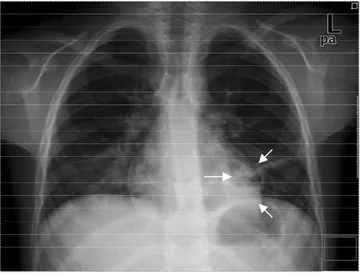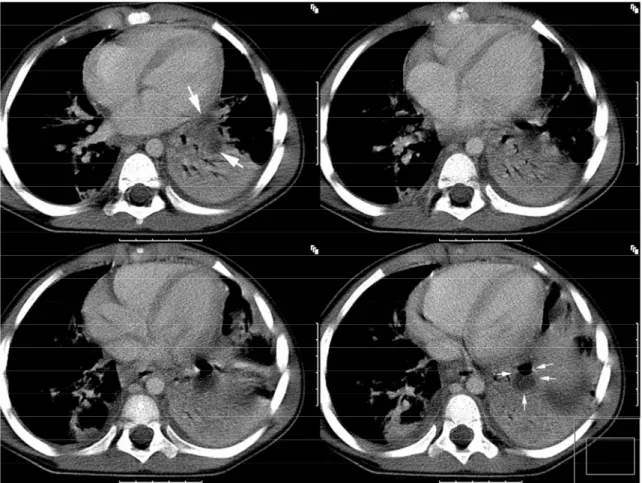Olgu Sunumu
© 2011 DEÜ
TIP FAKÜLTESİ DERGİSİ CİLT 25, SAYI2, (MAYIS) 2011, S: 103 - 106
103
Lung Abscess and Pneumatocele After
Accidentally Kerosene Ingestion in a Child
KAZA İLE GAZ YAĞI İÇİMİ SONRASI BİR ÇOCUKTA AKCİĞER APSESİ VE PNÖMOTOSEL
Tuba TUNCEL
1, Duygu ÖLMEZ
1, Arzu BABAYİĞİT
1, Özkan KARAMAN
1, Handan ÇAKMAKÇI
2,
Nevin UZUNER
11 Dokuz Eylül Üniversitesi Tıp Fakültesi, Çocuk Sağlığı ve Hastalıkları Anabilim Dalı, Çocuk Allerji Bilim Dalı 2 Dokuz Eylül Üniversitesi Tıp Fakültesi, Radyoloji Anabilim Dalı
Tuba TUNCEL
Dokuz Eylül Üniversitesi Tıp Fakültesi
Çocuk Alerji Bilim Dalı
Tel: (232) 4123662 Fax: (232) 4123601 GSM: (505) 2371475
SUMMARY
Hydrocarbon compounds are easily accessible products. Exposure to hydrocarbons is usually by accidental ingestion especially in children younger than 5 years. Pneumonitis is the most common complication of hydrocarbon ingestion. However; formation of lung abscess and pneumatoceles is believed to be a very rare event. Herein; we report a four year old child with hydrocarbon pneumonitis who had developed lung abscess and pneumotocele.
Key words: Hydrocarbon pneumonitis, lung abscess, child, pneumatocele ÖZET
Hidrokarbon bileşikleri kolaylıkla ulaşılabilen ürünlerdir. Hidrokarbonlara maruziyet genellikle kaza sonucu içme ile özellikle 5 yaş altı çocuklarda olur. Pnömonit hidro-karbon alımının en sık komplikasyonudur. Bununla birlikte akciğer apsesi ve pnömotosel oluşumunun oldukça nadir bir olay olduğuna inanılır. Burada akciğer apsesi ve pnömotosel gelişen hidrokarbon pnömonitli dört yaşında bir çocuk sunuldu.
Anahtar sözcükler: Hidrokarbon pnömoniti, akciğer apsesi, çocuk, pnömotosel
Kerosene is a low viscosity liquid hydrocarbon com‐ pound. Exposure to hydrocarbons is especially easier in lower socioeconomic status. The highest rates of morbidity and mortality result from accidental ingestion by children younger than 5 years. Pulmonary toxicity is the major cause of morbidity and mortality. It is followed by Central Nervous System (CNS) and cardiovascular complications (1).
CASE REPORT
A four year‐old girl was admitted to a local hospital because of unknown amount of kerosene ingestion acci‐
dentally. She was forced to vomit by her family. When she arrived the hospital, she was lethargic and dyspneic. Her chest X‐ray was normal on admission but after six hours the following X‐ray revealed pneumonic infiltration in the left lung. Oxygen, intravenous fluid therapy and par‐ enterally ceftriaxone were started. Although her neuro‐ logical status improved immediately, respiratory symp‐ toms and fever didn’t recover till the fifth day of the treatment and she referred to our hospital. On admission, she was tachypneic, dyspneic with respiratory rate 60/min and had intercostal retractions, body temperature was
Lung abscess and pneumatocele after accidentally kerosene ingestion in a child
104
38ºC (axillary), oxygen saturation was 97%. Breath sounds were diminished at the basis of left lung by auscultation of the chest. Laboratory evaluation showed leucocytosis (WBC; 14000/mm³), anemia (Hb; 10,5 gr/dl), high C‐reac‐ tive protein level (CRP: 245mg/L) and elevated liver en‐ zymes (SGOT:170 IU/L, SGPT:230 IU/L). Other laboratory findings were normal.
Chest X‐ray revealed pneumonic infiltration in the lower lobe of the left lung. Antibiotics were changed to teicoplanin and meropenem and 1 mg/kg/day predniso‐ lone was given additionally. Three days after this treat‐ ment, fever was ceased and her clinical status was im‐ proved. At the end of the first week of the treatment, chest X‐ray (Fig 1) and Computerized Tomography (CT) of tho‐ rax (Fig 2) showed decrease in infiltration but cavity with air‐fluid was evident in the lower lobe of the left lung. It was presumed as lung abscess. Antibiotics and predniso‐ lone were continued. White blood cell count, CRP and liver enzymes decreased to normal limits after ten days. Prednisolone was discontinued after two weeks. Her physical examination was completely normal and she had
no complaints at that time. On the third week of the anti‐ biotic treatment, abscess formation was disappeared but a thin walled pneumotocele was seen in chest X‐ray. Antibi‐ otic therapy was continued parenterally for four weeks. Chest X‐ray, taken about one month after the discharge (two months after accidentally ingestion), was completely normal.
DISCUSSION
Liquid hydrocarbons derived from petroleum are widely used in household and industry. These are easily accessible products. Most of the dangerous hydrocarbons are derived from petroleum distillates such as gasoline, furniture polish, household cleaners, kerosene, propel‐ lants, solvents and other fuels. Exposure may occur in different ways but the most common exposure type is accidental in children and it is related to the highest rates of morbidity and mortality (1). Improper storage and mislabeled containers of hydrocarbons are common con‐ tributing factors (2). In our case kerosene was stored in a bottle of water in the kitchen.
Lung abscess and pneumatocele after accidentally kerosene ingestion in a child
105
Figure 2. Computerized tomography of thorax (Abscess formation is marked with arrows)
As hepatic injury was recognized by cause of chronic exposure and certain hydrocarbon ingestion, it was not reviewed after acute kerosene ingestion (2). In our case liver enzymes were found elevated and it could not be explained with another disease and was recovered with‐ out any specific therapy.
Aspiration pneumonitis is the most common compli‐ cation of hydrocarbon ingestion (40%) (5). The toxic po‐ tential of hydrocarbons is directly related to their physical properties. Kerosene‐like highly volatile compounds with low viscosity are more likely to be inhaled or aspirated into the respiratory system (7). Clinical findings are coughing, choking, fever, cyanosis, tachypnea, grunting, wheezing, and rales. Initially, the chest X‐ray may be normal, but positive findings may develop after the first few hours of ingestion. Common findings include fine
perihilar opacities, bibasilar infiltrates, and atelectasis. Prophylactic use of antibiotics is not recommended for prevention of hydrocarbon pneumonitis (1). However once signs of secondary infection developed, antibiotic therapy should be started. Choice of antibiotic combina‐ tion should cover common gram positives, gram nega‐ tives, and anaerobes (8). Although effects of steroids are not explained and thought to be harmful, some authors and we believed that steroids accelerate clinic recovery (9‐ 10). In the presented case, symptoms improved immedi‐ ately after the beginning of the steroid therapy. However pneumatocele formation is a rare complication that occurs in approximately 4% of the patients with pneumonitis, only few cases with lung abscess were reviewed (11). Pneumatoceles generally appear lately (3‐15 days after accident) after the resolving of the consolidation. These
Lung abscess and pneumatocele after accidentally kerosene ingestion in a child
106
are often large, septate and irregular lesions and some‐ times contain air‐fluid levels. The majority of these lesions resolve almost completely with no residual pleural or par‐ enchymal scarring throughout for weeks and months (12‐ 14). In our case lung abscess appeared after the first week of the treatment and resolved with pneumatocele forma‐ tion in the third week of the treatment.
Although incidence of hydrocarbon pneumonitis de‐ creased, it still remains a problem in developing countries as our country. We reported this case because lung abscess and pneumatocele formation after hydrocarbon ingestion is rare and the patient was treated with corticosteroid and antibiotics without any sequel.
REFERENCES
1. Eade NR, Taussing LM, Marks MI. Hydrocarbon pneu-monitis. Pediatrics 1974; 54: 351- 357.
2. Klein BL, Simon JE. Hydrocarbon poisonings. Pediatr Clin North Am 1986; 33: 411- 419.
3. Lucas GN. Kerosene oil poisoning in children: a hospital-based prospective study in Sri Lanka. Indian J Pediatr 1994; 61: 683- 687.
4. Machado B, Cross K, Snodgrass WR. Accidental hydrocarbon ingestion cases telephoned to a regional poi-son center. Ann Emerg Med 1988;17: 804- 807.
5. Lifshitz M, Sofer S, Gorodischer R. Hydrocarbon poison-ing in children: a 5-year retrospective study. Wilderness Environ Med 2003; 14: 78- 82.
6. Shotar AM. Kerosene poisoning in childhood: a 6-year prospective study at the Princess Rahmat Teaching Hospital. Neuro Endocrinol Lett 2005;26: 835- 838. 7. Beamon RF, Siegel CJ, Landers G, Green V.
Hydrocar-bon ingestion in children: a six-year retrospective study. JACEP 1976; 5: 771- 775.
8. Singh H, Chugh JC, Shembesh AH, et al. Management of accidental kerosene ingestion. Ann Trop Paediatr 1992; 12: 105- 109.
9. Jamison K, Wallace E. Kerosene pneumonitis treated with adrenal steroids. California Med 1964;100: 43- 44. 10. Karacan Ö, Yılmaz İ, Eyüboğlu FÖ. Fire eater’s
pneumonia after aspiration of liquid paraffin. Turk J Pe-diatr 2006; 48: 85- 88.
11. Aziz AA, Abdullah FA, Mahmud A. Lung abscess rather than pneumatocele following kerosene ingestion. British Journal of Hosp Med 2007; 68: 616- 617.
12. Bergeson PS, Hales SW, Lustgarten MD, Lipow HW. Pneumatoceles following hydrocarbon ingestion. Report of three cases and review of the literature. Am J Dis Child 1975; 129: 49- 54.
13. Harris VJ, Brown R. Pneumatoceles as a complication of chemical pneumonia after hydrocarbon ingestion. Am J Roentgenol Radium Ther Nucl Med 1975;125:531-537. 14. Thalhammer GH, Eber E, Zach MS. Pneumonitis and
pneumatoceles following accidental hydrocarbon aspira-tion in children. Wien Klin Wochenschr 2005;117:150- 153.

